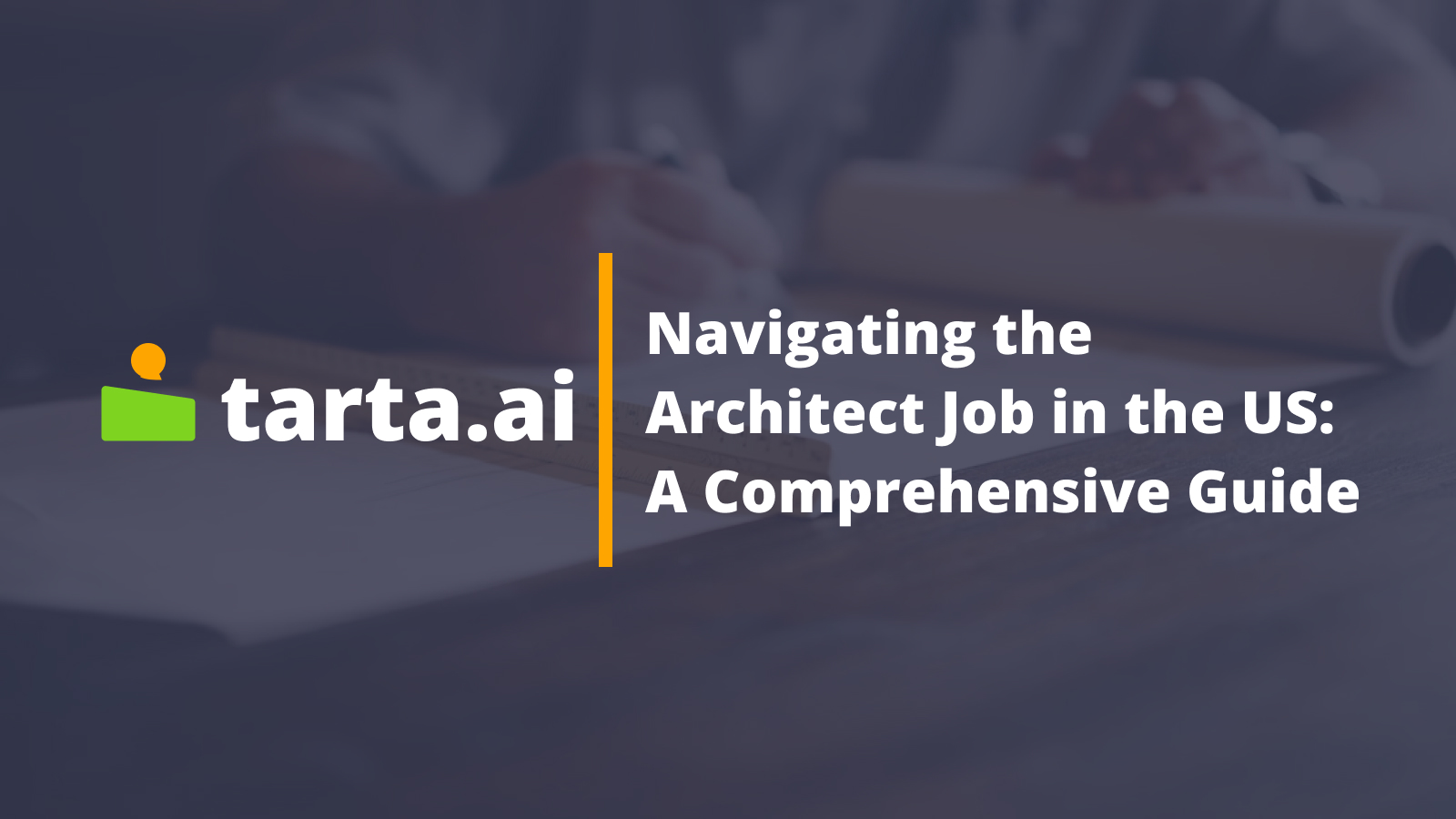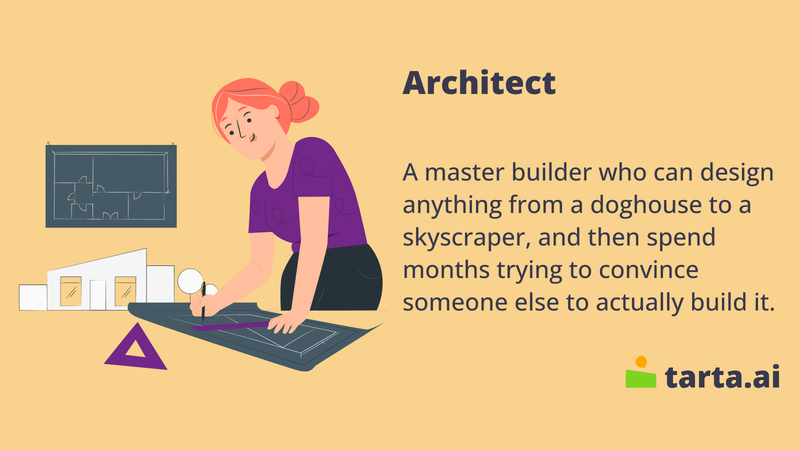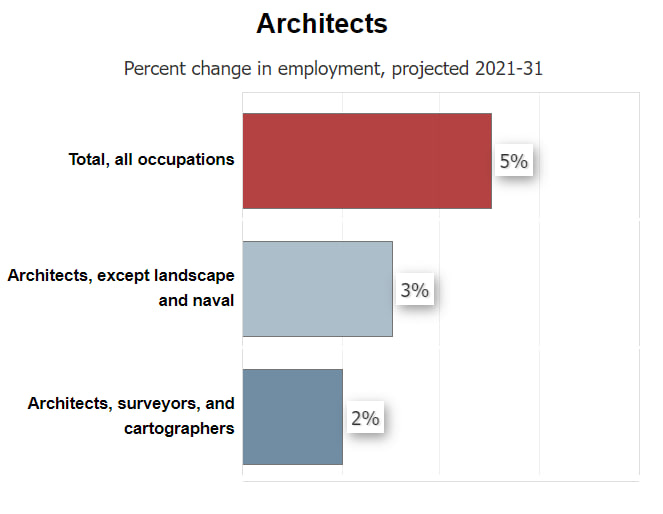Navigating the Architect Job in the US: A Comprehensive Guide

Architecture is a dynamic and rewarding profession that requires creativity, technical skills, and a passion for design. In this article, we explore the various aspects of the architecture profession in the United States, including education and training requirements, work environment settings and tools and technologies used by architects, different specializations available, career options beyond traditional architecture firms, the demand for architects and the trend towards remote work arrangements, and the pros and cons of the job. We also highlight several government programs available in the US to support architects. By providing a comprehensive overview of the architecture profession, we hope to help aspiring architects better understand what it takes to succeed in this exciting field.
Position Overview
An architect is a professional who designs and plans buildings and other structures. Architects are trained in the art and science of building design, construction, and engineering. They work closely with clients to determine their needs, preferences, and budget, and then create detailed plans and drawings for the construction of the building. Architects may work on a variety of structures, including residential homes, commercial buildings, public buildings, and landscapes. They must be knowledgeable about local building codes and regulations, and often work closely with engineers, contractors, and other professionals to ensure that their designs are safe, functional, and aesthetically pleasing.

Key Qualifications
To become an architect, one must typically complete a degree in architecture from an accredited university and gain practical experience through internships or apprenticeships. Key qualifications for an architect include:
- Education: A bachelor's or master's degree in architecture is typically required to become a licensed architect. The degree should be from an accredited university and provide a comprehensive education in architecture and related fields.
- Licensure: To practice as an architect in the United States, one must be licensed by the state in which they work. Licensure requirements typically include a degree in architecture, completion of an internship or apprenticeship, and passing a professional exam.
- Technical Skills: Architects must have a strong understanding of building design, construction, and engineering principles. They must also be proficient in using computer-aided design (CAD) software and other technical tools.
- Creativity: Architects must be creative thinkers who can translate their clients' needs and preferences into unique and functional designs.
- Communication: Architects must be effective communicators who can clearly explain their design ideas to clients, engineers, contractors, and other stakeholders.
- Attention to detail: Architects must pay close attention to detail to ensure that their designs are accurate and meet all building codes and regulations.
- Project management: Architects must be skilled at managing projects, including budgeting, scheduling, and overseeing construction.
Interesting fact:
Art competitions were once a part of the Olympics, including architecture.
Tasks and Expectations
The tasks and expectations of an architect can vary depending on the project they are working on, but some general tasks and expectations include:
- Meet with clients to discuss project goals and budget, and develop design concepts that meet their needs and preferences.
- Create detailed drawings and plans for building designs using computer-aided design (CAD) software.
- Work with engineers, contractors, and other professionals to ensure that designs are safe, functional, and meet all building codes and regulations.
- Manage projects, including budgeting, scheduling, and overseeing construction.
- Conduct site visits to monitor progress and ensure that the construction is following the plans and specifications.
- Keep up-to-date with the latest trends and developments in architecture, including sustainability, technology, and design.
- Work with clients to ensure that the final product meets their expectations and satisfaction.
- Collaborate with other professionals, such as landscape architects and interior designers, to create a cohesive and integrated design.
- Present designs to clients and other stakeholders, and be able to explain the rationale behind design decisions.
- Maintain accurate and organized project documentation, including contracts, specifications, and change orders.
Compensation
According to data from the U.S. Bureau of Labor Statistics (BLS) as of May 2021, the median annual wage for architects in the United States was $80,180. The lowest 10 percent earned less than $48,930, and the highest 10 percent earned more than $129,980. However, salaries can vary depending on factors such as location, experience, education, and the size and type of employer.

Source: U.S. Bureau of Labor Statistics
Strategies for Increasing Income
Architects can increase their income by:
Strategy | Description |
Gaining more experience | As architects gain more experience, they become more valuable to employers and can command higher salaries. |
Pursuing advanced education | Architects can pursue advanced degrees such as a master's degree or a Ph.D., which can lead to higher-paying positions. |
Obtaining additional certifications | Architects can obtain additional certifications such as the Leadership in Energy and Environmental Design (LEED) certification, which can increase their value to employers and lead to higher salaries. |
Working in high-demand areas | Architects who work in high-demand areas, such as urban centers or areas with rapidly growing populations, may be able to command higher salaries due to the demand for their services. |
Starting their own practice | Architects who start their own practice can potentially earn higher incomes if their business is successful. |
Networking | Architects who network with other professionals in the industry may be able to learn about higher-paying opportunities or even find higher-paying clients. |
Developing specialized skills | Architects who develop specialized skills in areas such as sustainable design, healthcare design, or historic preservation may be able to command higher salaries due to their unique expertise. |
Supplementary Perks
In addition to increasing their income, architects may be able to take advantage of additional benefits that can improve their overall compensation package. Some potential benefits include:
- Health insurance: Many employers offer health insurance plans as part of their benefits package, which can help architects save money on medical expenses.
- Retirement savings plans: Employers may offer retirement savings plans, such as 401(k) plans, that allow architects to save for retirement while also receiving tax benefits.
- Paid time off: Employers may offer paid time off, such as vacation days, sick days, or personal days, which can allow architects to take time off without sacrificing pay.
- Flexible work arrangements: Some employers may offer flexible work arrangements, such as telecommuting or flexible schedules, which can provide architects with a better work-life balance.
- Professional development opportunities: Employers may offer opportunities for professional development, such as continuing education courses or conferences, which can help architects improve their skills and advance their careers.
- Bonuses and profit-sharing: Some employers may offer bonuses or profit-sharing arrangements, which can provide architects with additional income based on the success of the company.
Architects may be able to increase their overall compensation package by considering not only their salary but also the additional benefits and perks that come with their employment.
Interesting fact:
LEGO made special bricks for architects called Modulex in 1963, but they were discontinued in the 1970s.
Work Environment
In this section, we will discuss the work environment settings and tools and technologies commonly used by architects. Architects work in a variety of settings, including offices, construction sites, and client meetings. They use a range of digital tools and technologies to create and modify designs, communicate with clients and colleagues, and manage the construction process. Understanding the work environment settings and tools and technologies used by architects can provide valuable insight into the field and help aspiring architects prepare for their future careers.

Photo: Daniel McCullough/Unsplash
Work Environment Settings
Architects typically work in offices, either in private firms or government agencies. They may also work on construction sites or visit clients to gather information and discuss project requirements.
Here are some specific work environment settings that may be relevant to architects:
- Office environment: Architects spend a significant amount of time working at their desks, reviewing plans and designs, and communicating with clients and colleagues. Therefore, a comfortable and well-lit office space with ergonomic furniture is important.
- Collaboration and communication: Architects often work as part of a team, collaborating with engineers, contractors, and other professionals. Therefore, it's essential to have good communication and collaboration tools, such as video conferencing software, project management software, and file-sharing tools.
- Construction sites: Architects also spend time on construction sites to oversee the building process and ensure that the project is progressing as planned. This requires safety equipment such as hard hats, safety glasses, and steel-toed boots.
- Travel: Architects may need to travel frequently to meet with clients, inspect construction sites, or attend conferences and workshops.
Architects require a mix of indoor and outdoor environments, including office spaces, construction sites, and travel opportunities. They need access to communication and collaboration tools, and safety equipment for construction site visits.
Tools and Technologies
Architects use a variety of tools and technologies to create and modify designs, communicate with clients and colleagues, and oversee the construction process. Here are some of the most common tools and technologies used by architects:
Tools and Technologies | Description |
Computer-Aided Design (CAD) software | This is one of the most essential tools for architects. CAD software enables architects to create, modify, and visualize designs in 2D and 3D. |
Building Information Modeling (BIM) software | BIM software is similar to CAD software, but it goes a step further by allowing architects to create digital models of buildings that contain detailed information about every component of the structure. |
Virtual and Augmented Reality (VR/AR) tools | These technologies allow architects to create immersive visualizations of their designs, enabling clients and stakeholders to experience the design in a more interactive and engaging way. |
Project management software | Architects use project management software to manage schedules, budgets, and resources, and to collaborate with team members and clients. |
3D printing | 3D printing technology allows architects to create physical models of their designs, enabling them to better communicate their ideas and designs to clients and stakeholders. |
Drones | Architects use drones to survey construction sites and obtain high-quality aerial footage that can be used in visualizations and presentations. |
Environmental modeling tools | These tools help architects analyze and optimize the environmental performance of buildings, including factors such as energy efficiency, daylighting, and thermal comfort. |
Mobile and cloud-based apps | These apps allow architects to access their designs and data from anywhere, collaborate with team members in real-time, and communicate with clients on the go. |
Architects use a variety of digital tools and technologies to create and manage designs, communicate with clients and colleagues, and oversee the construction process. These tools range from CAD and BIM software to VR/AR tools, project management software, 3D printing, drones, and environmental modeling tools.
Education and Training
Education and training for architects typically involve a combination of academic coursework, practical experience, and professional licensure.

Photo: Daniel McCullough/Unsplash
Academic coursework typically includes a Bachelor's or Master's degree in Architecture from an accredited program, which covers a range of subjects such as design theory, building materials, construction techniques, history of architecture, and architectural drafting and modeling.
Practical experience can be obtained through internships or apprenticeships with architectural firms, where aspiring architects can gain hands-on experience in the field and develop their skills in design, project management, and communication.
Professional licensure is required to practice as an architect in most countries, and it typically involves passing a series of exams that test knowledge and skills in areas such as building codes, zoning laws, and professional ethics.
Continuing education and training are also important for architects to stay up-to-date with the latest advancements in the field and to maintain their professional licensure. This can include attending seminars, workshops, and conferences, as well as pursuing advanced degrees or certifications in specialized areas of architecture.
Advancement Opportunities
In this section, we will discuss various specializations in the architecture industry, which can help architects focus on specific areas of expertise and build a rewarding career. We will also explore other career possibilities available to architects. These career options are diverse and offer architects opportunities to apply their skills and knowledge in various industries and fields. By the end of this section, you will have a better understanding of the different paths available to architects and be better equipped to make informed decisions about your career.
Specializations in Architect Industry
The field of architecture encompasses a wide range of specialties, including:
- Residential architecture: Focuses on designing homes, apartments, and other living spaces for individuals and families.
- Commercial architecture: Focuses on designing commercial buildings, such as offices, stores, and restaurants.
- Landscape architecture: Focuses on designing outdoor spaces, such as parks, gardens, and recreational areas.
- Sustainable architecture: Focuses on designing environmentally friendly buildings that are energy-efficient and use sustainable materials.
- Restoration and preservation architecture: Focuses on restoring and preserving historic buildings and structures.
- Industrial architecture: Focuses on designing buildings for industrial purposes, such as factories, warehouses, and power plants.
- Healthcare architecture: Focuses on designing hospitals, clinics, and other healthcare facilities.
- Educational architecture: Focuses on designing schools, universities, and other educational facilities.
These specializations often overlap and complement each other, and architects may specialize in multiple areas throughout their careers.

Photo: Sven Mieke/Unsplash
Other Career Possibilities
Apart from working as an architect in traditional architecture firms, there are several career options available for architects. Some of these career options include:
- Construction management: Architects can work in construction management, overseeing the construction process and ensuring that the building meets the design specifications.
- Real estate development: Architects can work in real estate development, which involves acquiring land and developing it for commercial or residential purposes.
- Urban planning: Architects can work in urban planning, where they are involved in developing plans and policies for cities and urban areas.
- Project management: Architects can work as project managers, overseeing the design and construction of buildings.
- Building inspection: Architects can work in building inspection, ensuring that buildings comply with building codes and regulations.
- Facility management: Architects can work in facility management, where they oversee the maintenance and upkeep of buildings.
- Interior design: Architects can also work in interior design, designing the interiors of buildings, including furniture, fixtures, and finishes.
- Academia: Architects can also work as professors or instructors in architecture schools and universities.
These are just a few of the many career options available to architects, and many architects may transition between different roles throughout their careers.
Interesting fact:
The popular video game The Sims was originally designed as an architecture simulator.
Employment Trends
In this section, we will discuss two important aspects of the architecture profession in the United States: the demand for architects and the trend towards remote work arrangements. First, we will explore the projected growth of the architecture industry and the factors that may influence demand for architects in the US. Then, we will discuss the increasing prevalence of remote work arrangements within the architecture profession, including the benefits and challenges of these arrangements for architects.
Architect Demand
According to the United States Bureau of Labor Statistics, the employment of architects is projected to grow 3 percent from 2020 to 2030, which is slower than the average for all occupations.

Source: U.S. Bureau of Labor Statistics, Employment Projections program
The demand for architects in the US may vary depending on factors such as the economy, population growth, urbanization, and infrastructure development. Architecture firms may experience fluctuations in demand based on changes in the construction industry, building codes and regulations, and environmental concerns.
There is likely to be a continued need for architects to design and plan new construction projects, including homes, commercial buildings, and public infrastructure. Additionally, architects who specialize in sustainable design and energy-efficient building practices may be particularly in demand as environmental concerns become increasingly important.
Remote Work Arrangements
Remote work arrangements for architects have become more common in recent years, especially in response to the COVID-19 pandemic. Many architecture firms have implemented flexible work policies, such as part-time or compressed workweeks, job sharing, and telecommuting options.
Remote work arrangements have also become more prevalent, allowing architects to work from home or other locations outside of the office. This can be particularly beneficial for architects who need to collaborate with clients, engineers, or contractors in different locations.
However, the nature of architecture work often requires in-person meetings, site visits, and collaboration with other team members. Therefore, while remote work can be useful for some aspects of the job, it may not be feasible for all projects and may require a mix of remote and in-person work.
Remote work arrangements can offer benefits such as increased work-life balance, reduced commute time, and greater autonomy. It's important for architects to ensure that they are still able to effectively communicate and collaborate with their team members and clients while working remotely.
Interesting fact:
The Cooper Union Foundation Building in New York City had an elevator shaft even though modern elevators hadn't been invented yet.
Job Fulfillment
In this section, we will be discussing the pros and cons of the architect job. Architecture is a dynamic and rewarding field, but it also comes with its own set of challenges. By exploring both the advantages and disadvantages of working as an architect, we hope to provide a comprehensive view of what it is like to work in this profession.
Pros | Cons |
Creative expression As an architect, you have the opportunity to use your creativity and imagination to design unique buildings and spaces that can leave a lasting impact on the people who use them. | High pressure Architects have a lot of responsibility, as their designs can have a significant impact on people's lives. This can create a high-pressure work environment that is not suited for everyone. |
Job satisfaction Architects often feel a sense of pride and accomplishment when they see their designs come to life, whether it's a building, a park, or a public space. | Long hours Architects often work long hours, especially during the design and construction phases of a project. This can lead to a poor work-life balance and high levels of stress. |
Diverse career opportunities Architects can work in a variety of fields, including residential, commercial, and public sector projects. They can also specialize in areas such as sustainable design, historic preservation, or urban planning. | High educational requirements Becoming an architect requires a significant amount of education and training. It typically involves obtaining a bachelor's degree in architecture, completing an internship, and passing a licensing exam. |
High earning potential Architects can earn a good salary, especially as they gain experience and advance in their careers. | Limited job security The architecture field can be cyclical, with periods of high demand followed by periods of low demand. This can lead to job instability for architects, especially those who work for small firms or are self-employed. |

Photo: Sven Mieke/Unsplash
Government Programs
There are several government programs in the US that provide support and resources for architects, including:
- Small Business Administration (SBA) - The SBA provides resources and support for small businesses, including architecture firms. They offer loan programs, business counseling, and training opportunities.
- General Services Administration (GSA) - The GSA manages and supports federal government buildings and facilities. Architects can find opportunities to bid on federal contracts through the GSA's Design and Construction Division.
- National Endowment for the Arts (NEA) - The NEA provides grants and funding for arts and culture programs, including architecture. Architects can apply for grants to support their projects or research.
- National Council of Architectural Registration Boards (NCARB) - The NCARB is a non-profit organization that regulates the practice of architecture in the US. They offer support and resources for architects, including licensure and continuing education programs.
- Federal Emergency Management Agency (FEMA) - FEMA provides support for disaster response and recovery efforts. Architects can find opportunities to contribute to disaster relief efforts through FEMA.
These are just a few examples of government programs that provide support for architects in the US. Architects can also look for state-level programs and resources in their local communities.

Photo: Karolina Grabowska/Pexels
In conclusion, architecture is a challenging yet rewarding profession that offers a variety of career paths and opportunities for growth and development. Architects play a crucial role in designing and planning buildings and other structures that meet the needs of society while also reflecting artistic expression and functional design. From education and training requirements to work environment settings and tools and technologies used, to the different specializations available and career options beyond traditional architecture firms, this article has provided a comprehensive overview of the architecture profession in the United States. By understanding the various aspects of the profession, aspiring architects can better prepare themselves for a successful career in architecture. With the support of government programs and resources, architects can continue to shape the built environment and make a positive impact on the communities they serve.
- To become an architect, one must typically complete a degree in architecture from an accredited university, gain practical experience through internships or apprenticeships, and obtain professional licensure.
- Architects can work in various environments, including offices, construction sites, and client meetings. They use digital tools and technologies such as CAD software, BIM software, VR/AR tools, and 3D printing.
- Architects can specialize in areas such as residential and commercial architecture, landscape architecture, sustainable architecture, interior design, and restoration and preservation architecture, among others. They can also pursue career paths beyond traditional architecture firms.
- The demand for architects is projected to grow, and remote work arrangements are becoming more prevalent in the profession.
- Pros of working as an architect include creative expression, job satisfaction, diverse career opportunities, and high earning potential. Cons include long hours, high pressure, high educational requirements, and limited job security.
- Architects can take advantage of government programs and resources such as the SBA, GSA, NEA, NCARB, and FEMA to support their work.
FAQ
What skills are important for an architect?
Important skills for an architect include creativity, attention to detail, strong technical and problem-solving abilities, communication and teamwork skills, and the ability to work with clients and contractors.
What types of projects might an architect work on?
Architects can work on a wide range of projects, including residential, commercial, industrial, and institutional buildings, as well as landscape design, urban planning, and restoration and preservation of historic structures.
How important is sustainability in architecture?
Sustainability is becoming increasingly important in architecture as the world focuses on reducing carbon emissions and protecting the environment. Architects can incorporate sustainable design principles into their work to create buildings that are energy-efficient, use environmentally-friendly materials, and promote healthy living.
What are some ethical considerations in architecture?
Architects have ethical responsibilities to their clients, the public, and the environment. They must adhere to professional standards of conduct, prioritize safety and well-being, and consider the long-term impact of their designs.